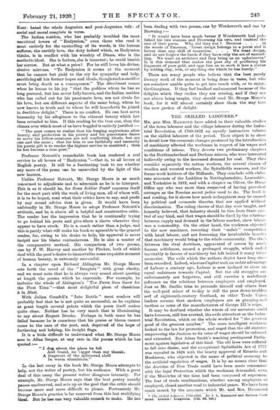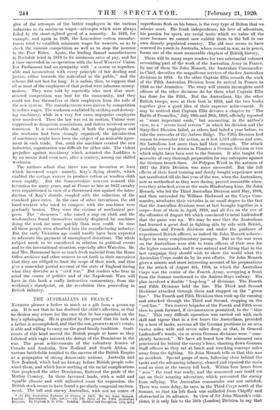THE SKILLED LABOURER.*
MR. AND MRS. HAMMOND have added to their valuable studies of the town labourer and the village labourer during the Indus- trial Revolution of 1760-1832 an equally instructive volume on the skilled labourer of the period. Their object is to show in detail how the economic changes produced by the introduction of machinery affected the workman in respect of his wages and conditions of labour. They devote two preliminary chapters to the Northumberland and Durham miners, who were interested indirectly owing to the increased demand for coal. They then consider separately the cotton workers, the several classes of woollen and worsted workers, the Spitalfields weavers, and the frame-work knitters of the Midlands. They conclude with elabo- rate accounts of the Luddites in Nottinghamshire, Lancashire, and Yorkshire in 1812, and with a chapter on Oliver, the Home Office spy who was more than suspected of having provoked outrages as the Russian secret police used to do. The book is sad reading, for it shows how much unhappiness may be caused by political and economic theories that are applied without discrimination. The ruling classes of that day were taught, and honestly believed, that industry should be free from State con- trol of any kind, and that wages should be fixed by the relations between supply and demand in the labour market, since labour was a commodity. On the other hand, the workmen objected to the new machines, resenting their " unfair" competition with hand labour, and not foreseeing the incalculable benefit that machinery would bring to the whole community. The clan't between the rival doctrines, aggravated of course by much human selfishness, caused a prolonged struggle, which ended inevitably in favour of machinery but left behind it many bitter memories. The evils which the authors depict have long sine,. been remedied. Indeed, whereas Capital took an unfair advantage of Labour a century ago, Labour is now inclined to show an equal unfairness towards CapitaL But the old struggles are unfortunately not forgotten, and still exercise a maleficent influence on the relations between employers and employed. Just as Mr. Smillie tries to persuade himself and others that the well-paid miner of to-day is still the poor down-trodden serf of eighteenth-century Scotland, so other Trade Union leaders assume that modern employers are as grasping and
tactless as some of the manufacturers of George reign.
It may be doubted whether the wisest of our ancestors could have foreseen, still less averted, the evils attendant on the Indus- trial Revolution, which on the whole worked for " the greatest good of the greatest number." The more intelligent workmen looked to the law for protection, and urged that the old statutes empowering the Justices to fix rates of wages should be enforced and extended. But Adam Smith's teaching predisposed Parlia- ment against legislation of this kind. The old laws were suffered to fall into disuse, and the exceptional Spitalfields Act of 1773 was repealed in 1824 with the hearty approval of Ricardo and Huskisson, who objected in the name of political economy to the artificial regulation of wages. It is by no means clear that the doctrine of Free Trade could have been made consonant with the legal Protection which the workman demanded, even if the Ministries of the time had been composed of supermen. The fear of trade combinations, whether among employers or employed, closed another road to industrial peace. We have been much struck by the accounts which Mr. and Mrs. Hammond
• The Skilkd Labourer. 1760-1882. By J. L. Hammond lad Barbara Haus. mond. Londoa Lougmani. [1211. ad. nothl give of the attempts of the better employers in the various industries to fix minimum wages—attempts which were always foiled by the short-sighted greed of a minority. In 1819, for example, and again in 1826, the Lancashire cotton manufac- turers tried to establish minimum wages for weavers, so as to check the ruinous competition as well as to stop the increase in the Poor Rates. Again, the leading flannel manufacturers in Rochdale tried in 1819 to fix minimum rates of pay, and for a time succeeded in co-operation with the local Weavers' Union. But Parliament had no sympathy with " a course so reprehen- sible and inconsistent with every principle of fair dealing and justice, either towards the individual or the public," and the scheme did not last for long. It is unfair, then, to suppose that all or most of the employers of that period were inhuman money- makers. They were told by reputedly wise men that unre- stricted competition was best for the community, and they could not free themselves or their employees from the toils of the new system. The manufacturers were driven by competition to reduce wages. The workmen retaliated by striking and destroy- ing machinery, while in a very few cases unpopular employers were murdered. Then the law was set in motion, Unions were suppressed as dangerous associations, and rioters received severe sentences. It is conceivable that, if both the employers and the workmen had been strongly organized, the introduction of machinery might have been the subject of an amicable agree- ment in each trade. But, until the machines created the new industries, organization was difficult for either side. The violent prejudice against machinery which actuated the Luddites is by no means dead even now, after a century, among our skilled workmen.
The authors admit that there was one invention at least which increased wages—namely, Kay's flying shuttle, which enabled the cottage weaver to produce cotton or woollen cloth more rapidly. But the Somersetshire weavers resisted this invention for many years, and at Frome as late as 1822 cavalry were requisitioned in view of a threatened riot against the intro- duction of Kay's shuttle, coupled with the reduction of the standard piece-rates. In the case of other inventions, the old hand-workers who tried to compete with the machines were gradually beaten. They were the victims of mechanical pro- gress. The " shearmen " who raised a nap on cloth and the woolcombers found themselves entirely displaced by machines doing the work far more quickly than men could. In time all these people were absorbed into the manufacturing industry. But the early Victorian age could hardly have been expected to advocate the payment of unemployed donations. The whole subject needs to be considered in relation to political events and to the international situation, especially after Waterloo. Mr. and Mrs. Hammond have so much fresh material from the Home Office archives and other sources to set forth in their narratives that they are obliged to limit the scope of their work, and thus give a somewhat partial account of the state of England during what they describe as a " civil war." But readers who bear in mind the course of politics and of the Napoleonic Wars will have in this book a really instructive commentary, from the workman's standpoint, on the revolution then proceeding in British industry.



































 Previous page
Previous page